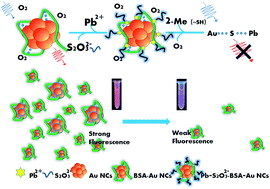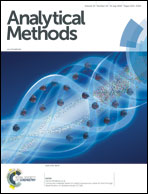A redox route for the fluorescence detection of lead ions in sorghum, river water and tap water and a desk study of a paper-based probe†
Abstract
In this paper, we developed a label-free fluorescence assay employing BSA-Au NCs, S2O32−, and 2-ME for the highly selective and sensitive detection of Pb2+ in sorghum, river water and tap water. When the BSA-Au NCs reacted with S2O32− in solution, Au(S2O3)23− complexes were formed immediately on the surfaces of BSA-Au NCs. After adding Pb2+ and 2-ME, the BSA-Au NCs rapidly dissolved to form Au–S complexes. As a result, the fluorescence intensity decreased dramatically, allowing quantification of Pb2+ in the aqueous solution. This reaction is highly specific under optimal detection conditions. A good linear relationship between the fluorescence intensity and the concentrations of Pb2+ could be obtained in the range of 10 to 1000 nM (R2 = 0.9910), with a detection limit (LOD; S/N ratio = 3) down to 1.043 nM. Significantly, compared with other studies, we greatly shortened the reaction time by substantial improvements in materials. On the basis of the above-mentioned work, we successfully immobilized S2O32− modified BSA-Au NCs on wax-printed papers to achieve the purpose of simple and real-time field monitoring of Pb2+. We picked up R-values (the red value of the RGB color model) from captured flurescence images under UV light (365 nm) and acquired a linear correlation between R-values and Pb2+ concentrations. This linear correlation exhibits the great potential of this approach. The proposed probe also showed satisfactory selectivity as well as excellent reproducibility. Multiple real sample experiments showed the tremendous prospect of this method, as well.



 Please wait while we load your content...
Please wait while we load your content...